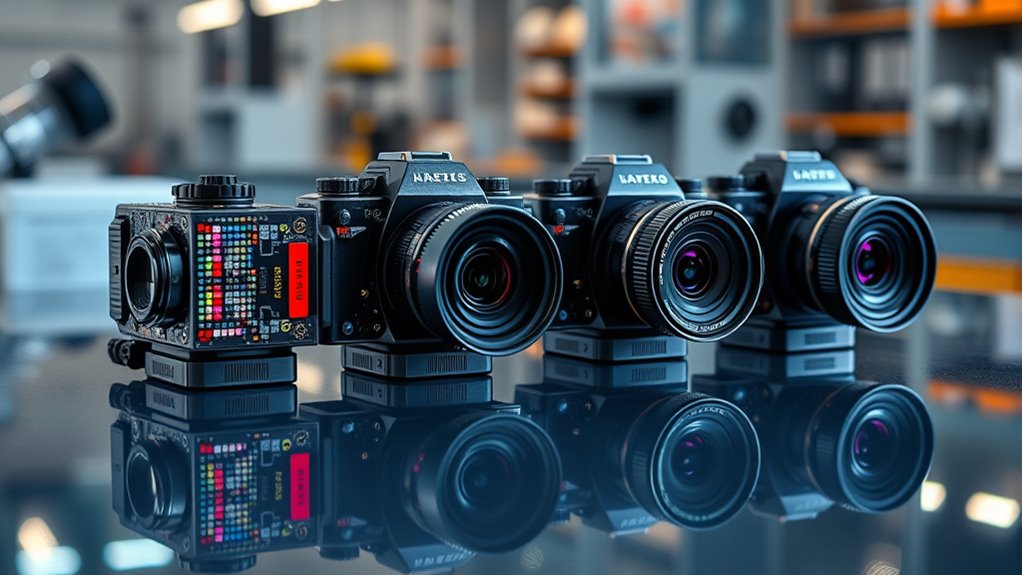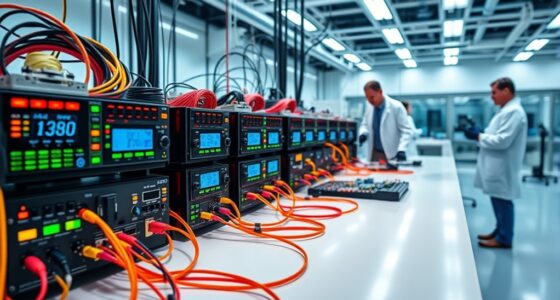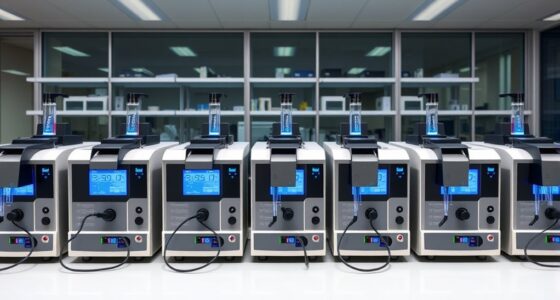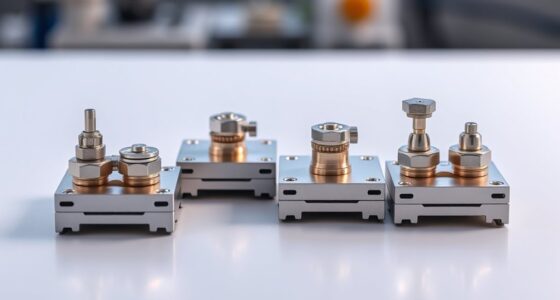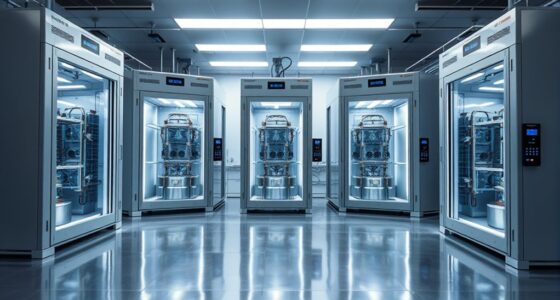If you’re after the best hyperspectral cameras of 2025, I recommend models like the MAXDONE Solar Trail Camera, which combines high resolution with rugged outdoor durability and wireless control. The GardePro A3S and E5S stand out with impressive 64MP sensors, advanced night vision, and weather resistance suitable for demanding environments. These options excel in precision imaging, but to find the perfect fit for your needs, there’s more to explore below.
Key Takeaways
- High-resolution hyperspectral sensors like 64MP models enable detailed spectral imaging for environmental and security applications.
- Rugged, weather-resistant designs (IP66/IP69K) ensure durability in demanding outdoor and research environments.
- Advanced onboard processing and compatibility with GPU or cloud platforms facilitate real-time spectral data analysis.
- Wireless connectivity options support remote control and quick data transfer for field deployments.
- Emerging innovations in sensor sensitivity and spectral range improve accuracy and precision in diverse imaging scenarios.
MAXDONE Solar Trail Camera with WiFi & Bluetooth, 48MP, 30fps, Rechargeable Battery
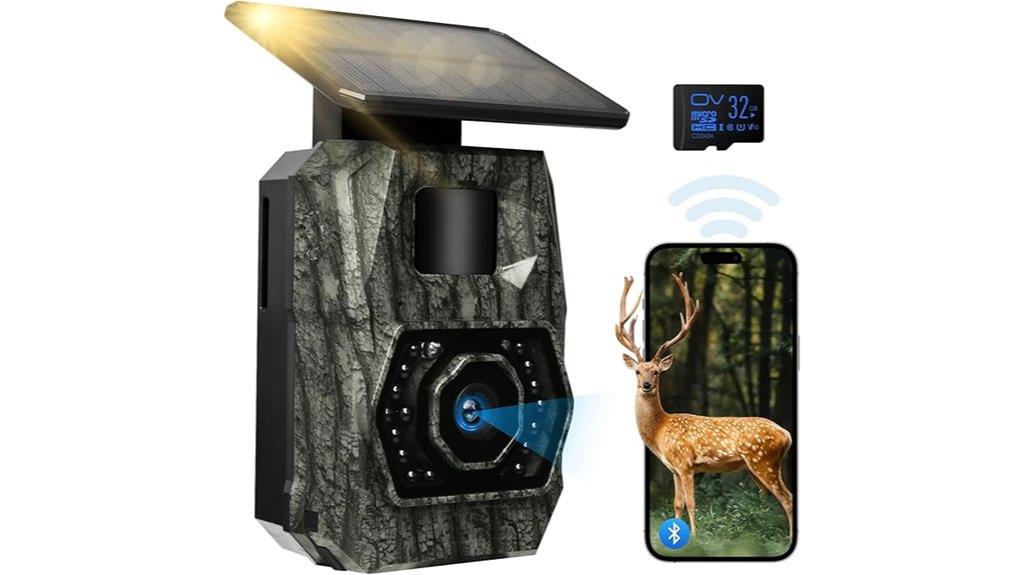
If you’re looking for a reliable trail camera that combines high-quality imaging with outdoor durability, the MAXDONE Solar Trail Camera is an excellent choice. It features a powerful 48MP sensor for sharp photos and 1296P HD videos at 30fps, ensuring clear wildlife captures. The built-in solar panel and 5200mAh rechargeable battery provide long-lasting power, while its IP66 rating means it withstands harsh weather conditions. With a quick 0.1s trigger speed, wide detection angle, and night vision range of 65 feet, it’s perfect for remote monitoring. Plus, WiFi and Bluetooth connectivity let you control and transfer data easily through the free app.
Best For: outdoor enthusiasts, wildlife observers, and security-conscious individuals seeking a durable, high-resolution trail camera with remote control capabilities.
Pros:
- High-quality 48MP still images and 1296P HD videos with fast 0.1s trigger speed
- Solar-powered with a long-lasting 5200mAh rechargeable battery for extended outdoor use
- Wireless connectivity via WiFi and Bluetooth for easy remote access and data transfer with the free app
Cons:
- Requires proper setup to ensure optimal WiFi Bluetooth range and connectivity
- Limited internal storage, so additional SD cards may be necessary for extensive monitoring
- The IP66 rating, while weather-resistant, may not be suitable for extremely harsh environments or submersion
GardePro A3S Trail Camera 2 Pack
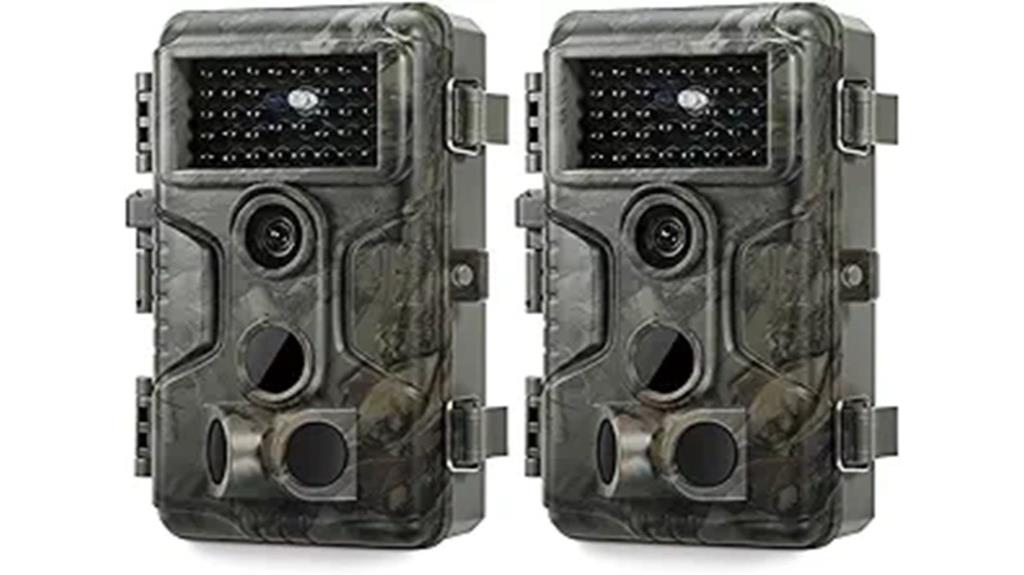
The GardePro A3S Trail Camera 2 Pack stands out as an excellent choice for outdoor enthusiasts and wildlife professionals seeking reliable, high-quality monitoring tools. It captures sharp 64MP images with a Sony Starvis sensor and records HD videos with clear sound. Night vision uses no-glow infrared LEDs, providing visibility up to 100 feet without alerting animals or intruders. Its rapid 0.1-second trigger speed and adjustable detection zones ensure quick, accurate captures. Durable and weather-resistant, it supports large SD cards and offers user-friendly features like a color LCD screen, timestamp, and firmware updates. This pack combines affordability, performance, and ease of use, making it perfect for extensive outdoor monitoring.
Best For: outdoor enthusiasts, wildlife professionals, and security users seeking reliable, high-quality trail monitoring in various environments.
Pros:
- Sharp 64MP images with Sony Starvis sensor for vivid, crisp photos
- Rapid 0.1-second trigger speed and adjustable detection zones for accurate, quick captures
- Durable, weather-resistant design with large SD card support and user-friendly LCD interface
Cons:
- Close objects within 10-15 feet may produce blurry images
- Left arrow button for deletion can accidentally remove photos, requiring caution
- Night vision clarity can vary depending on environmental conditions and distance
GardePro E5S Trail Camera with 64MP and 100ft Night Vision
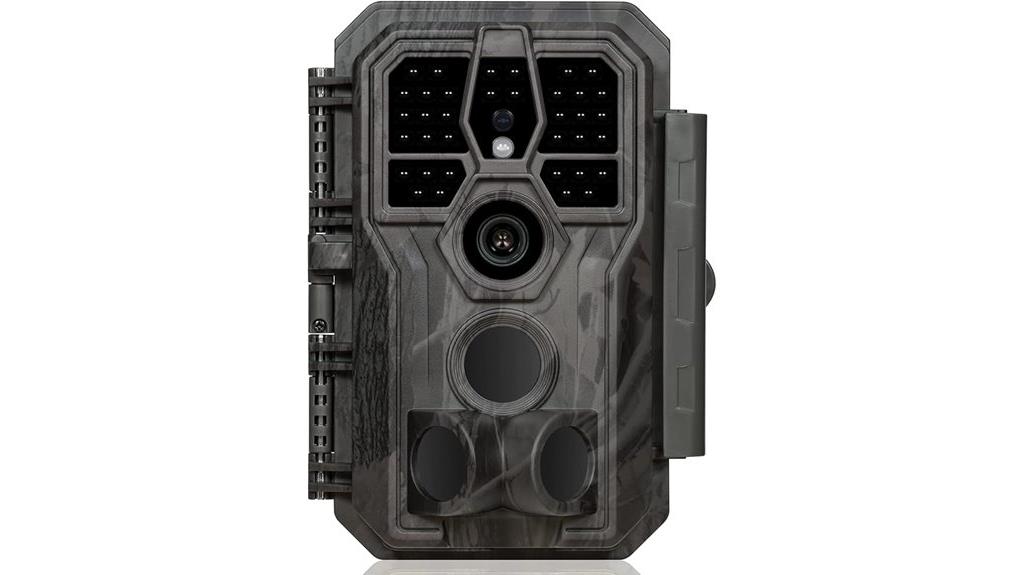
Designed for outdoor enthusiasts and security-conscious users, the GardePro E5S Trail Camera stands out with its impressive 64MP still images and 100-foot night vision. It captures crisp photos using a starlight optical lens and sensor, with smooth 1296p HD videos in MP4 and MOV formats. The no-glow IR technology guarantees discreet nighttime operation, while features like motion detection in 0.1 seconds and a 90-foot detection range boost reliability. Its waterproof IP66 rating, easy setup, and versatile mounting options make it suitable for wildlife monitoring or security. Although some durability concerns exist, overall, it offers excellent image quality and performance at an affordable price point.
Best For: outdoor wildlife enthusiasts, security-conscious users, and casual observers seeking high-quality images and discreet night vision.
Pros:
- 64MP still images and 1296p HD video capture for clear, detailed visuals
- No-glow IR night vision with 100-foot range for discreet nighttime monitoring
- Waterproof IP66 rating and easy setup with versatile mounting options
Cons:
- Reports of durability issues with some units failing after 6-18 weeks
- No wireless connectivity; requires manual data transfer via USB or SD card
- Occasional choppy video footage or camera malfunctions despite good initial performance
GardePro A3S Trail Camera, 64MP 1296p Game Camera
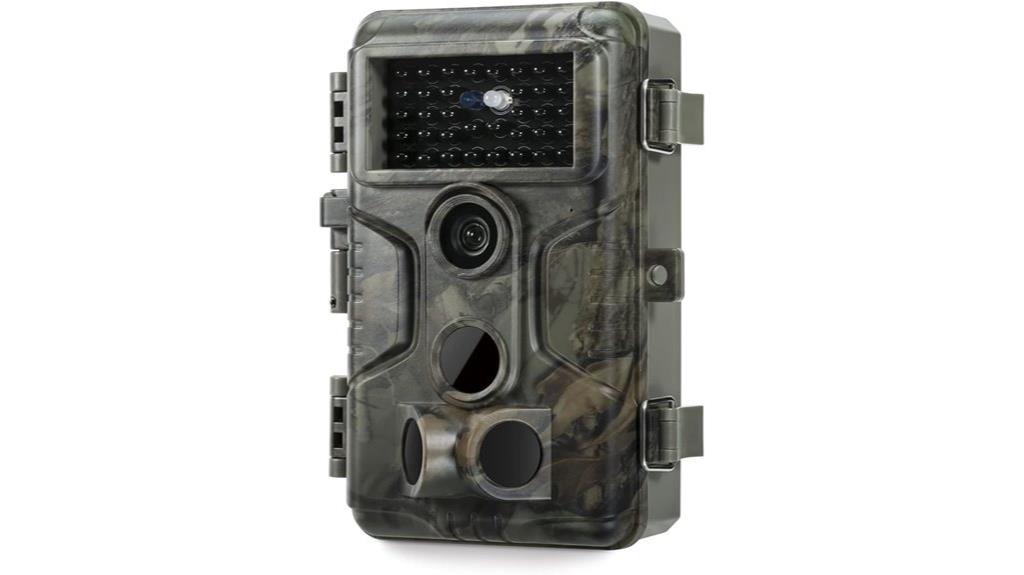
For wildlife enthusiasts and outdoor monitoring professionals, the GardePro A3S Trail Camera stands out with its impressive 64MP image resolution and 1296p video quality, ensuring crystal-clear footage even in challenging conditions. It features excellent night vision thanks to its Sony Starvis sensor and no-glow infrared LEDs, capturing clear images up to 100 feet in darkness. Its fast 0.1-second trigger speed, combined with three PIR sensors and pre-activation tech, captures quick-moving animals reliably. Built tough with IP69K waterproofing, it operates on long-lasting batteries and supports SD cards up to 512GB. Overall, it’s a durable, high-performance camera ideal for wildlife monitoring and property surveillance.
Best For: wildlife enthusiasts and outdoor monitoring professionals seeking high-resolution images, reliable night vision, and durable performance for wildlife tracking or property surveillance.
Pros:
- Exceptional 64MP photo quality and 1296p video resolution ensure crystal-clear footage in all conditions
- Fast 0.1-second trigger speed with multiple shot capability captures quick-moving animals effectively
- Rugged, waterproof design with IP69K rating and long-lasting batteries suitable for extended outdoor use
Cons:
- Firmware updates may be limited depending on the series version, affecting some features
- Occasional false triggers can occur without proper sensitivity calibration
- Audio quality can sometimes be muffled, reducing clarity in sound recordings
Factors to Consider When Choosing Hyperspectral Cameras
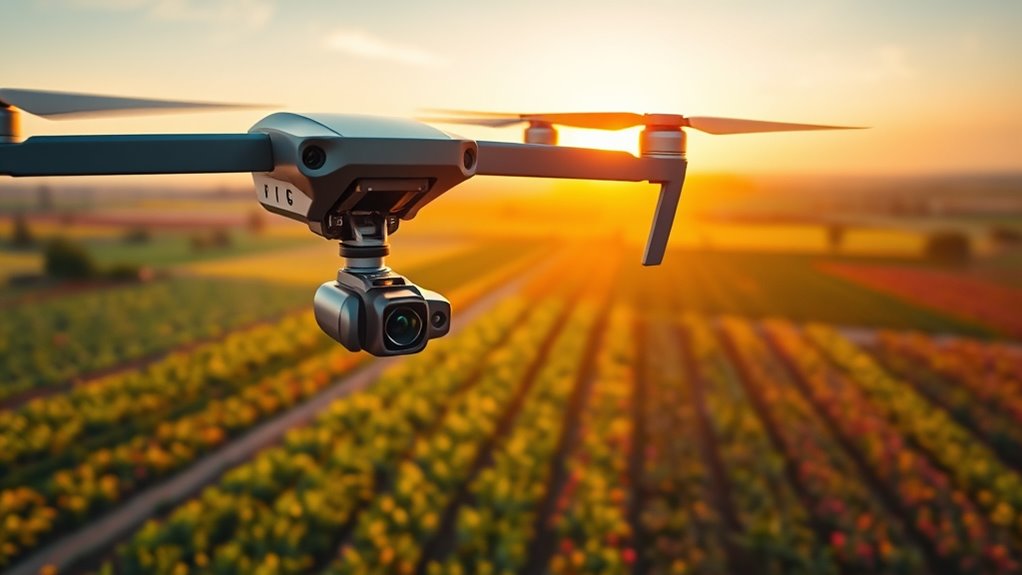
When selecting a hyperspectral camera, I consider several key factors to guarantee it meets my needs. I look at the spectral range coverage, spatial resolution, and data processing requirements to match my project goals. Additionally, I evaluate light sensitivity and durability features to choose a reliable device for various conditions.
Spectral Range Coverage
Choosing the right hyperspectral camera hinges largely on its spectral range coverage, as this determines what wavelengths it can detect and analyze. I look for cameras that capture data across dozens to hundreds of narrow spectral bands, providing detailed spectral signatures. The spectral range typically extends from ultraviolet (UV) through visible (VIS), near-infrared (NIR), and into short-wave infrared (SWIR), depending on my specific needs. A broader range enables more extensive material identification, vital for applications like mineral exploration or environmental monitoring. It also affects the camera’s ability to penetrate atmospheric conditions such as fog or smoke, which is fundamental for certain environments. Ultimately, selecting a camera with the appropriate spectral coverage ensures I can accurately detect and analyze the materials or features I’m targeting.
Spatial Resolution Quality
The spatial resolution of a hyperspectral camera determines the smallest details it can distinguish in an image, directly impacting the level of detail and precision available for analysis. Higher spatial resolution means more detailed images, allowing me to evaluate small features and subtle variations accurately. Many cameras offer adjustable resolution settings, so I can optimize for either finer detail or smaller data volume, depending on my needs. Factors like sensor design, lens quality, and the distance from the scene influence resolution. I need to take into account these factors carefully because there’s often a trade-off between spatial resolution and other parameters like spectral resolution or frame rate. Balancing these elements ensures I get the best image detail without compromising overall system performance.
Data Processing Needs
Since hyperspectral cameras produce vast amounts of spectral data, I need to contemplate how I’ll process and analyze this information effectively. Handling such large datasets requires specialized software and powerful computing resources like GPUs or cloud platforms to guarantee quick analysis. The choice of algorithms—such as dimensionality reduction or classification methods—directly influences the accuracy and usability of the imagery. For real-time or near-real-time applications, I must prioritize optimized processing pipelines to reduce latency and support timely decisions. Additionally, my data processing approach should align with my project’s goals, whether it’s mineral detection, vegetation health, or environmental monitoring. By considering these factors, I can select a hyperspectral camera that not only captures quality data but also fits seamlessly into my analytical workflow.
Light Sensitivity Levels
High light sensitivity is crucial when selecting hyperspectral cameras, especially for applications in low-light environments or during nighttime imaging. This feature determines how well the camera detects subtle spectral variations, which is indispensable for accurate analysis in fields like mineral exploration or plant health monitoring. Cameras with enhanced sensitivity often use specialized sensors, such as cooled CCDs or sCMOS, to improve their signal-to-noise ratio in challenging lighting conditions. Adjustable exposure settings and gain controls allow me to optimize light sensitivity based on ambient light levels and specific imaging needs. Without sufficient sensitivity, spectral accuracy and image quality suffer, making it harder to gather reliable data in environments with limited natural illumination. Prioritizing light sensitivity ensures precise, high-quality hyperspectral imaging in all lighting conditions.
Device Durability Features
Choosing a hyperspectral camera that can withstand tough outdoor conditions requires paying close attention to its durability features. Look for models with an IP66 or higher waterproof rating to handle rain, dust, and humidity. Rugged, shock-resistant housings protect internal sensors from impacts and vibrations during transport or rough handling. An operating temperature range of -20°C to 60°C ensures reliable performance in extreme cold or heat. Reinforced seals and corrosion-resistant materials help extend the device’s lifespan when exposed to moisture and environmental contaminants. Additionally, robust power options like rechargeable batteries or solar compatibility support long field deployments without frequent maintenance. Prioritizing these durability features ensures your hyperspectral camera remains reliable and functional in challenging conditions, maximizing your investment and data quality over time.
Power and Battery Life
Durability features guarantee that hyperspectral cameras can withstand tough outdoor conditions, but understanding their power and battery capabilities is equally important for reliable field operation. These cameras usually demand significant power due to their advanced sensors and data processing, often requiring sturdy power sources. Battery life varies widely, depending on factors like sensor resolution, data acquisition frequency, and onboard processing, with some units running for hours or even days on a single charge. Many models include rechargeable batteries and options for external power sources or solar panels, extending operational time in remote settings. Power consumption surges during active data collection, especially with high-resolution imaging or real-time analysis. Efficient power management features, such as sleep modes and customizable schedules, are essential to maximize battery life during extended field deployments.
Cost and Budget
Selecting the right hyperspectral camera involves balancing your budget with your specific needs, as prices can vary widely. Basic models can cost a few thousand dollars, while advanced systems with high spectral and spatial resolution can exceed $100,000. Keep in mind that the initial purchase isn’t the only expense—calibration, maintenance, software licenses, and potential upgrades add to the total cost of ownership. Cheaper cameras often have lower spectral resolution or reduced data processing capabilities, which might impact accuracy or scope. It’s essential to evaluate whether the camera’s features align with your application requirements to avoid overspending on unnecessary options or sacrificing critical performance. Careful consideration ensures you invest wisely without compromising your project’s success.
Intended Application Fit
To guarantee you get the most out of your hyperspectral camera, it’s essential to match its capabilities to your specific application needs. First, confirm the spectral range covers the wavelengths relevant to your work, whether for agriculture, mineral exploration, or environmental monitoring. Next, verify that the spatial and spectral resolutions align with your precision requirements, whether for detailed material analysis or broad surveys. Consider how fast the camera can acquire data and process it in real-time, especially if your environment is dynamic. Compatibility with your existing systems, including software and data formats, is also critical. Lastly, assess the camera’s durability and environmental specs, like weather resistance and temperature tolerance, to ensure reliable performance in your operational setting.
Frequently Asked Questions
How Do Hyperspectral Cameras Differ From Traditional RGB Cameras?
Hyperspectral cameras differ from traditional RGB cameras by capturing much more detailed spectral information across hundreds of narrow bands, unlike RGB cameras that record only three broad colors. This allows me to analyze materials, detect hidden features, and identify chemical compositions with greater precision. While RGB cameras give me visual images, hyperspectral cameras provide a wealth of data for scientific, agricultural, and industrial applications, making them far more versatile for detailed analysis.
What Are the Primary Applications of Hyperspectral Imaging in 2025?
In 2025, I see hyperspectral imaging primarily used in agriculture, environmental monitoring, and medical diagnostics. It helps me analyze crop health, detect pollutants, and identify disease markers with incredible precision. I love how this technology reveals details invisible to the naked eye, making it essential for smarter decision-making. Whether improving sustainability or advancing healthcare, hyperspectral imaging is transforming how we comprehend and interact with our world.
How Does Sensor Resolution Impact Hyperspectral Camera Performance?
Sensor resolution directly impacts a hyperspectral camera’s performance by determining the level of detail it captures. Higher resolution means sharper images with more precise spectral data, which improves analysis accuracy. However, increased resolution can also lead to larger data sets, requiring more processing power. I find that balancing resolution with data management is key to optimizing a camera’s effectiveness for specific applications, whether in agriculture, mineralogy, or environmental monitoring.
What Advancements Are Expected in Hyperspectral Camera Technology by 2025?
Think of hyperspectral cameras as explorers charting unseen worlds. By 2025, I expect they’ll be more like wise guides—smaller, faster, and smarter. Advances will likely include enhanced spectral range, improved sensitivity, and AI-driven data processing, revealing hidden details with unprecedented clarity. These innovations will unleash new possibilities in agriculture, environmental monitoring, and defense, transforming how we see and understand the world around us.
How Important Is Software Integration for Hyperspectral Camera Effectiveness?
Software integration is absolutely essential for hyperspectral camera effectiveness. It allows me to process and analyze the vast amount of data these cameras capture quickly and accurately. Seamless software integration ensures real-time insights, easier calibration, and better image management. Without it, the raw data wouldn’t be as useful, and I’d struggle to leverage the full potential of the hyperspectral imaging system for precise applications.
Conclusion
In my opinion, these hyperspectral cameras are truly game-changers, transforming how we see the world in astonishing detail. Whether you’re capturing wildlife or conducting precision imaging, these top picks will elevate your work to new heights. Trust me, once you experience their clarity and depth, you’ll wonder how you ever managed without them—it’s like opening a secret universe right in your hands. Don’t settle for less; these tools are worth every penny!
